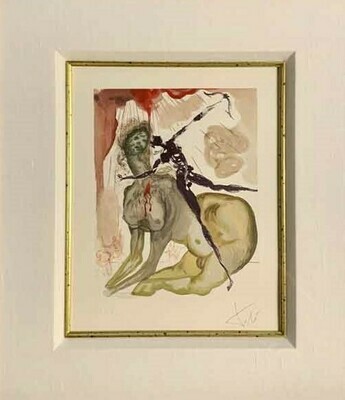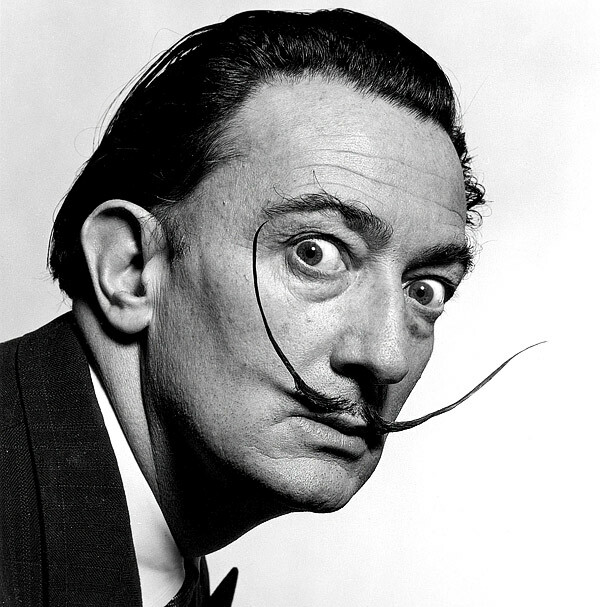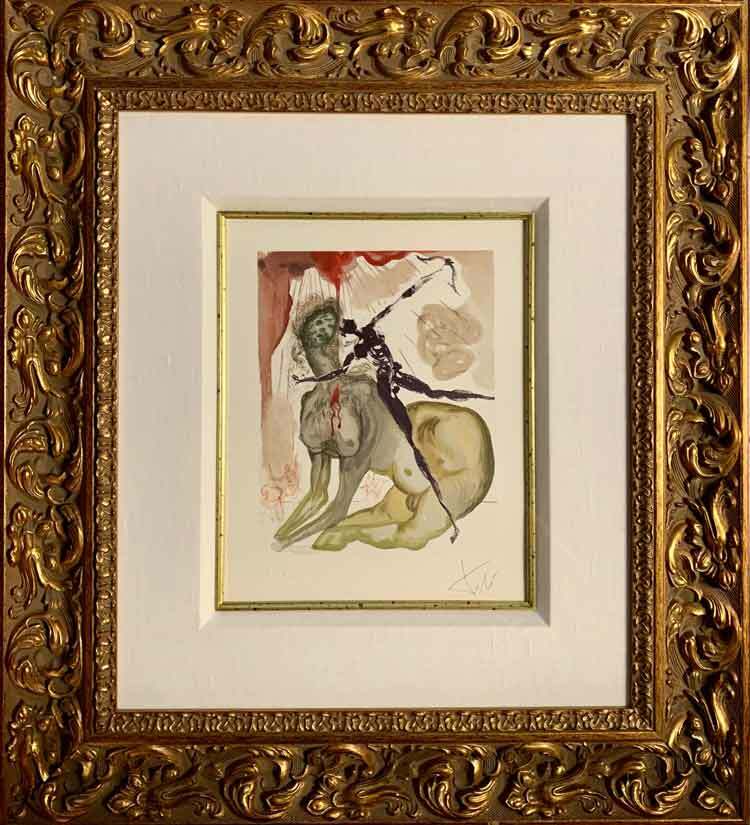00029

Artist: Salvador Dali
Title: Inferno 12 The Minotaur, Hell Canto #17
Nationality: Spanish (1904-1989)
Medium: Woodblock Signed in Pencil, 1963
Dimensions: 9″ x 12″ & 22″ x 26"
Edition: Hand signed with Jean Estrada (print maker) embossing
Provenance: Albert Fields compliant
Salvador Dali Divine Comedy
In anticipation of the 700th anniversary of Alighieri's birth, in 1957 the Italian government commissioned Dalí to create a complete set of illustrations, one for each canto of the "Divine Comedy." But soon after the artist began planning imagery for each of the 100 watercolor paintings, the government withdrew the commission under pressure from Italian citizens who were peeved that the job went to a Spanish artist rather than one of their own. Undeterred, Dalí continued the work, finishing the hundred works in nine years without funding or even a guaranteed publisher, trusting that support would come.
Soon after, the images were painstakingly translated into a set of wood engravings by expert engravers overseen by Dalí and Jean Estrade, artistic director of Parisian publisher Les Heures Claires. This task required about 3,500 separate plates to be etched for the 100 prints, with 40 or 50 blocks for some of the more complex and colorful images, according to provided information. The skillful translation was so complete, capturing every brushy stroke and watery wash of the original watercolors.
Salvador Dali – (1904-1989) Born in Figueras, Spanish surrealist painter and printmaker, Dali is best known for his explorations of subconscious imagery. From his melting clock to the burning giraffe, Dali rallied against the tradition of pre-meditated painting, preferring to draw upon his subconscious mind to bring imagery to life. Having left art school before taking his final exam, Dali estranged himself from his father. Dali felt his instructors were not qualified to exam him as an artist. He also knew that upon graduation he would no longer enjoy financial assistance from his father. He was a good student though, developing a vast number of artistic styles, showing great technical skills as a painter. In the 1920’s his discovery of the writings of Sigmund Freud on the significance of subconscious imagery led to his involvement in the Paris-based Surrealist movement, a group of artist and writers to sought to establish the “greater reality” of the human subconscious over reason. Dali began to induce hallucinatory states in himself by a process he described as “paranoiac critical.” Once the artist hit on that method, his painting style matured with extraordinary rapidity. From 1929 to 1937 he produced paintings which made him the world’s best-known surrealist artist. He depicted a dream world in which commonplace objects are juxtaposed, deformed or otherwise metamorphosed in a bizarre and irrational way. Dali portrayed these objects in a meticulously realistic detail, placing them within bleak, sunlit landscapes reminiscent of his Catalonian homeland. In the late 1930s Dalí switched to painting in a more-academic style under the influence of the Renaissance painter Raphael. Known for his ambivalent political views during the rise of fascism, he was alienated from his surrealist colleagues resulting in his expulsion from the group. Thereafter, he spent much of his time designing theater sets, interiors of fashionable shops, and jewelry. Feeling Europe during the war, he is noted for his flamboyant self-promotion stunts in the United States where he lived from 1940 to 1955. During this period and into the 70’s, Dalí painted many works with religious themes, though he continued to explore erotic subjects, to represent childhood memories, and to use themes centering on his wife, Gala. Notwithstanding their technical accomplishments, those later paintings are not as highly regarded as the artist’s earlier works.

